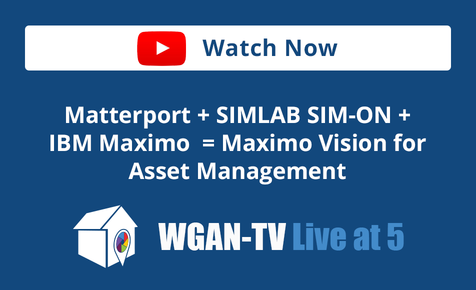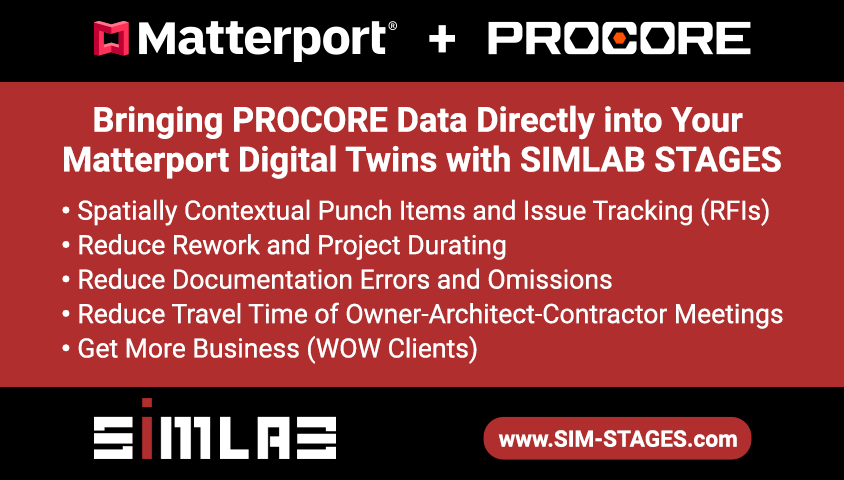264-WGAN-TV on Location | CupixWorks for Construction Management; CupixVista for 3D Point Cloud & Texture Mesh
Geo Week 2024 in Denver (Colorado Convention Center) 11-13 February 2024 | Matterport Digital Twin courtesy of MatterFix.io Founder Mike Vorce (@MatterFix)
264-WGAN-TV on Location at Geo Week 2024
CupixWorks for Construction Management; CupixVista for 3D Point Cloud and Texture Mesh
About This Episode (Written by ChatGPT-4. Lightly edited by @DanSmigrod)
In this episode of WGAN-TV, recorded on location at Geo Week 2024 in Denver, WGAN-TV Managing Editor and Host Dan Smigrod talks with Cupix Vice President of Product Marketing Chuck Pfeffer. Chuck talks about the Cupix 3D technology platforms, CupixWorks and CupixVista, exploring their applications in construction management, project monitoring, and beyond.
Key Points Discussed
CupixWorks: A cloud-based collaborative platform designed primarily for construction management. It enables users to capture, visualize, and track progress in 3D using off-the-shelf 360-degree cameras. This platform supports frequent data capture, integrates various data types (including laser scans and drone data), and facilitates clash detection and issue management through BIM coordination.
CupixVista: A forthcoming pay-per-scan solution that simplifies the process of converting 360-degree camera footage into 3D point clouds and textured meshes. This tool is geared towards DIY scanning for a variety of applications, from surveying to facility management, offering a cost-effective alternative to traditional laser scanning methods.
Technology and Cameras: Discussion on the use of advanced photogrammetry, SLAM algorithms, and AI to create detailed point clouds and textured meshes from 360 video. Cupix primarily utilizes cameras like the Ricoh THETA X and Insta360 models, emphasizing their affordability and accessibility for users.
Market Applications: Insights into the "sweet spots" for Cupix's technology, including construction project management, facility renovations, and documentation for insurance purposes. The versatility of Cupix's platforms opens up opportunities for real estate photographers, service providers, and AEC professionals to enhance their workflows and decision-making processes.
Future Directions: Chuck shares his vision for the future of data collection and analysis, emphasizing the ease and accuracy of Cupix's solutions. The conversation also touches on the potential expansion into crime scene documentation and insurance claim support, showcasing the wide-ranging applications of 3D technology.
Conclusion
Chuck Pfeffer's insights offer a glimpse into the innovative world of 3D technology and its transformative impact on construction management, documentation, and a host of other industries. With Cupix's user-friendly platforms, professionals across various fields can harness the power of 3D data to streamline their operations, enhance accuracy, and drive decision-making.
Thank You to Our Guest
A special thank you to Chuck Pfeffer for joining us at Geo Week 2024 and sharing the exciting developments at Cupix. Stay tuned for more insights and innovations from the forefront of 3D technology.
For more episodes and exclusive content, visit the We Get Around Network Forum and watch the WGAN-TV Podcast.
===
Transcript (video above)
- Hi, I am Chuck Pfeffer, Vice President of Product Marketing at Cupix, here at Geo Week.
I'm here to tell you a little bit about Cupix and our products and our software. So we have two platforms. CupixWorks is a cloud-based collaborative platform that's used mainly in construction management.
It allows you to capture data in 3D and visualize it and then also capture it over and over and over again so you can do progress tracking within a construction project. We use primarily, for our collection device, 360-degree cameras.
We pretty much, just the off the shelf cameras that are between $300 and $800, and by a simple video walk through a construction site, you can not only collect the virtual walkthrough of 3D panoramic, but you also collect point cloud and textured mapping, which is a textured mesh that can be exported or visualized within our product. The product allows you to capture as frequently as you want.
It also brings in other data to complement that, so if you have laser scanning, you can bring in laser scans, if you have drone data, you can bring in drone data, and then it all gets coordinated with a BIM, so you can have all the federated models in the system as well so you can do clash detection against as-built, you can do comparisons between the as-built and the design to look for issues, and then you can find issues early and manage that so your project continues on time.
We also have a product called CupixVista, which will be coming out very soon, and that's effectively a pay-per-scan system where you use the same 360 cameras, but instead of putting it into this collaborative, cloud-based environment, you can upload it to our processing and download it as a 3D point cloud and textured mesh that you can visualize and export for use in other applications, so if you wanted to do, for example, scan the BIM with 360 capture, you could walk a job site or walk up an area, upload that, download it, and then just take that point cloud to your process to create your BIM from that scan.
- [Dan Smigrod] What are your sweet spots for CupixWorks and for CupixVista?
- Vista. Yeah, so for CupixWorks, managing construction projects, so it's usually brought in by a BIM/VDC manager into a GC, and then the GCs use it but they can share it with all the subs who can use it as well, so you can manage the complete project that way.
Also, even on the design and architecture side, that information is helpful if you're doing a renovation to a as-built condition. CupixVista is really that wide open just scan system that, sort of in the Goldilocks area where it's 99% accurate to a laser scan, but it's an $800 camera which anyone can use, so it's a do-it-yourself scanning for surveying, open areas or just documenting facilities for facility management, just where you need that scan and take it and go.
- [Dan Smigrod] And which cameras is Cupix using?
- So here, we're actually focusing on the Ricoh THETA X, which is a automatic GPS geo-reference, so it's built into the actual data. We also work with the Insta360 ONE X2 and the Insta360 ONE RS 1-Inch.
- [Dan Smigrod] And you mentioned an $800 camera, so that's the Ricoh THETA X.
- The Ricoh THETA X is $800. The Insta360 ONE RS 1-Inch is also about $800.
- [Dan Smigrod] And you talked about, in addition to the 360 photography creating point clouds, so is that created from the 360 photography?
- That's right, so we use advanced photogrammetry and SLAM algorithms and AI to generate that point cloud and textured mesh, so that comes just from the video that's generated from those cameras.
- [Dan Smigrod] And if you're a real estate photographer that's specializing in 3D/60 content creation, is there an opportunity for service providers to be involved with Cupix? Is it that they have a client that has a need, or is there a need by Cupix to outsource jobs that you have to content creators that are intimate with 360/3D photography?
- I would say we provide a solution for those content creators, so we we're not doing any of that collection service of the data.
We're just a way to facilitate the creation of the usable data. If there's a customer that needs to have a scan, the great thing about Cupix is a customer could actually do it themselves with CupixVista, it's that easy. If they want to outsource this, then there are plenty of service companies who are using Cupix, both CupixWorks and CupixVista, that would be able to do that for them.
- [Dan Smigrod] And in terms of, "so I'm a service provider and I am talking to clients in the AEC space, what would be the typical title of a person who would be the decision maker for this kind of content creation?"
- On the GC side, on the contractor side? Yeah, that would usually be the BIM/VDC specialist. They're usually the people who are looking to bring the technology into their processes, and so that's the person who would champion it.
It ultimately would be deployed in the field by the project manager and the people on the site who are actually collecting the data, but everyone in the whole project would be able to access the data through the cloud-based interface, so, from the designers to the project managers to the stakeholders to even the owners, they all could see the data at the same time.
- [Dan Smigrod] Is there a question I haven't asked you about either CupixWorks or CupixVista that I should ask you about?
- I think it's just sort of, the future is really ... we're really creating this easy way to collect data to make decisions faster and to avoid issues in the field, so being proactive by collecting this data that used to maybe only be collected monthly or quarterly, now it's so easy and accurate enough that you can collect it every week or every few days on a construction site and make decisions based on real-world information.
- [Dan Smigrod] So what you're describing is weekly, monthly, quarterly construction progress monitoring. Are there other kinds of use cases that CupixWorks and CupixVista are being used for in addition to timely construction progress monitoring?
- Right, yeah, there, yes, there are, and actually to go beyond that, for the monitoring, we also have a product that, SiteInsights, it's an add-on that automatically tracks your progress for you, comparing it to the BIM automatically.
But outside of that, yes, I'd say on the very front-end of a project, really any project, you want to know the scope of it, doing a quick scan where you can just go in and send anyone in, an estimator or a business development person, and scan a site to bring it back to the estimators, that's a quick and easy way without having to invest in a laser scan service if that's not what you do or buy a laser scanner, so it's an easy way to get an understanding of a job site at the beginning, and not for progress, but just to decide how would you bid that job?
- [Dan Smigrod] So would you describe that as an as-built?
- Yes, you're looking at the as-built, or the existing conditions of the site, whether there's cleanup that needs to be done or there's a hazard there, and it's all there in 3D and in panoramic view, it's measurable, if there's a pile of something, you could walk around it, you can calculate the area, how much volume actually is in a pile to see what needs to be moved.
Jumping to some other potential applications I'd see for CupixVista, which as I said is new, is I presented at a forensics conference last week being able to replace what people are doing with laser scans with 360 video is a fast and easy way to get a lot more crime scenes documented, which now it's just based on the availability of the high-tech equipment.
Also for insurance, documenting things for insurance, so you have comprehensive information, 3D and 2D panoramas of an existing condition for insurance.
- [Dan Smigrod] Is Cupix also be being used for insurance claim documentation, water damage, fire damage?
- Yeah, it could be used before and after, for sure. If you have it before, it's even better than when you do it after. Absolutely.
- [Dan Smigrod] Thank you very much.
- Sure, thank you. |




















